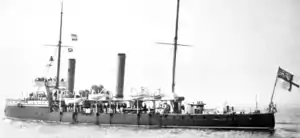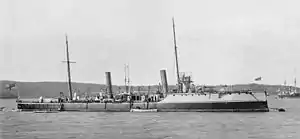 HMS Spanker | |
| Class overview | |
|---|---|
| Name | Sharpshooter-class torpedo gunboat |
| Builders |
|
| Operators | |
| Preceded by | Grasshopper class |
| Succeeded by | Alarm class |
| Subclasses | Almirante Lynch class |
| Built | 1888–1891 |
| In commission | 1889–1922[1] |
| Completed | 13 |
| Lost | 1 |
| Scrapped | 12 |
| General characteristics [1] | |
| Type | Torpedo gunboat |
| Displacement | 735 tons |
| Length | 242 ft (74 m) oa, 230 ft (70 m) pp |
| Beam | 27 ft (8.2 m) |
| Draught | 8 ft 6 in (2.59 m) |
| Installed power |
|
| Propulsion |
|
| Speed | 19 kn (35 km/h) |
| Range | 2,500 nmi (4,600 km) at 10 kn (19 km/h) |
| Complement | 91 |
| Armament |
|
The Sharpshooter-class torpedo gunboat was a class of torpedo gunboat built for the Royal Navy in the late 19th century. One of the class was hulked in 1904, seven were scrapped before World War I and five were converted to minesweepers. Of these minesweepers, Seagull was lost to a collision in 1918 and the rest survived the war to be broken up in the early 1920s.
Design
The Sharpshooter class was designed by Sir William White in 1888. They had a length overall of 242 ft (74 m), a beam of 27 ft (8.2 m) and a displacement of 735 tons.[1] They were engined with two sets of Belliss and Morcom triple-expansion steam engines, two locomotive-type boilers, and twin screws. This layout produced 2,500 indicated horsepower (1,900 kW) with natural draught and 3,600 indicated horsepower (2,700 kW) with forced draught, giving them a top speed of 19 knots (35 km/h).[1] They carried 100 tons of coal, giving them a range of about 2,500 nautical miles (4,600 km) at 10 knots (19 km/h) and were manned by 91 sailors and officers. The following Alarm class were essentially an enlarged version of the Sharpshooters.[1]
From 1895 to 1898 a series of different boilers were fitted to Sharpshooter, Sheldrake, Seagull, Spanker and Salamander.[1]
Armament
At build the class was fitted with two QF 4.7-inch (12 cm)/45-pounder guns and four 3-pounder guns. Five 14-inch (360 mm) torpedo tubes were fitted, except in Plassey and Assaye, which had three tubes. Three reloads were provided.[1]
Those vessels converted to minesweepers in 1909 retained their guns and had a kite winch and gallows fitted on the quarterdeck.[2]
Service
Plassey and Assaye were built for the Bombay Marine (renamed the Royal Indian Marine in 1892). Whiting and Wizard (renamed Boomerang and Karakatta before commissioning) were assigned to the Australia Station. Seven of the class, including all the colonial service boats, were sold for breaking in 1904 - 1907, and five of the class were converted to minesweepers in 1908 - 1909. Of the five minesweepers, Seagull was lost in a collision with SS Corrib in the Clyde in 1918,[2] and the others were sold for breaking after World War I. Sharpshooter was hulked for instructional duties in 1904 and renamed Northampton, surviving until 1922 until being sold for breaking.[1]

Ships
| Name | Ship builder | Laid down | Launched | Completed | Fate |
|---|---|---|---|---|---|
| Sharpshooter | Devonport Dockyard | 13 January 1888 | 30 November 1888 | August 1889 | Hulked for instructional duties and renamed Northampton in 1904 (or later). Sold for breaking on 27 March 1922 |
| Spanker | Devonport Dockyard | 12 April 1888 | 22 February 1889 | 17 October 1890 | Became a minesweeper in 1909. Sold for breaking on 20 March 1920 |
| Speedwell | Devonport Dockyard | 18 April 1888 | 15 March 1889 | 1 July 1890 | Became a minesweeper in 1909. Sold for breaking on 20 March 1920 |
| Salamander | Chatham Dockyard | 23 April 1888 | 31 May 1889 | 8 July 1891 | Sold for breaking on 15 May 1906 |
| Seagull | Chatham Dockyard | 23 April 1888 | 31 May 1889 | 1 December 1890 | Became a minesweeper in 1909. Sunk in a collision in the Firth of Clyde on 30 September 1918 |
| Sheldrake | Chatham Dockyard | 4 July 1888 | 30 March 1889 | 18 March 1890 | Sold for breaking on 9 July 1907 |
| Skipjack | Chatham Dockyard | 4 July 1888 | 30 April 1889 | 14 February 1891 | Became a minesweeper in 1909. Sold for breaking on 23 April 1920 |
| Boomerang | Armstrong Mitchell, Elswick | 17 August 1888 | 24 July 1889 | 14 February 1891 | Laid down as Whiting, renamed Boomerang on 2 April 1890. Sold at Portsmouth on 11 July 1905 |
| Karakatta | Armstrong Mitchell, Elswick | 17 August 1888 | 27 August 1889 | 14 February 1891 | Laid down as Wizard, renamed Karakatta on 2 April 1890. Sold at Portsmouth on 11 January 1905 |
| Assaye | Armstrong Mitchell, Elswick | 19 November 1888 | 11 February 1890 | January 1892 | Built for the Royal Indian Marine. Sold in May 1904 |
| Plassey | Armstrong Mitchell, Elswick | 19 November 1888 | 5 July 1890 | February 1892 | Built for the Royal Indian Marine. Sold on 17 May 1904 |
| Gossamer | Sheerness Dockyard | 21 January 1889 | 9 January 1890 | 16 June 1891 | Became a minesweeper in 1908. Sold for breaking on 20 March 1920 |
| Gleaner | Sheerness Dockyard | 21 January 1889 | 9 January 1890 | 21 December 1891 | Sold for breaking on 4 April 1905 |
See also
References
Bibliography
- Brown, Les (2023). Royal Navy Torpedo Vessels. Barnsley, UK: Seaforth Publishing. ISBN 978-1-3990-2285-9.
- Colledge, J. J.; Warlow, Ben (2006) [1969]. Ships of the Royal Navy: The Complete Record of all Fighting Ships of the Royal Navy (Rev. ed.). London: Chatham Publishing. ISBN 978-1-86176-281-8.
- Winfield, R.; Lyon, D. (2004). The Sail and Steam Navy List: All the Ships of the Royal Navy 1815–1889. London: Chatham Publishing. ISBN 978-1-86176-032-6. OCLC 52620555.